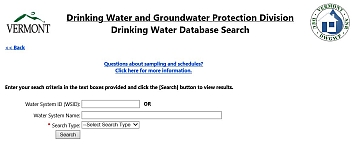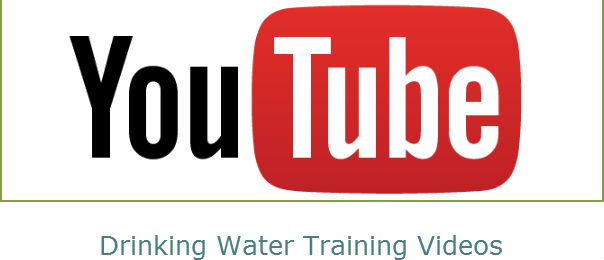Act 66 was passed in 2019 and subsequently adopted under the Vermont Environmental Health Rules in July 2020 as the "Rule Governing Testing and Remediation of Lead in the Drinking Water of Schools and Child Care Facilities". The Rule requires all Vermont school districts, supervisory unions, independent schools, and child care providers to test their drinking and cooking water for lead. If lead is found at or above the action level of 4 parts per billion (ppb), the school or child care provider must immediately take the tap out of service and take corrective action to eliminate or reduce the amount of lead to below the action level.
The Rule is primarily under the authority of the Vermont Department of Health (VDH), with support from the Agency of Education, Department of Children and Families Child Care Licensing, and Department of Environmental Conservation (DEC). DEC staff oversee the remediation portion of the program when lead tap results are at or above the Vermont school lead action level, 4 ppb.
For more information about the VDH Lead Testing Rule, visit the VDH Lead in Schools and Childcare Website
Monitoring and remediation requirements under the VDH Lead Testing Rule are separate from any requirements under the federal Lead and Copper Rule (LCR). A school or childcare facility that has its own well and is regulated as a public water system must comply with the LCR requirements as well as the VDH Lead Testing Rule. DEC sent an email to Vermont NTNC schools and child care facilities summarizing requirements under the two programs (federal LCR and the VDH Lead Testing Rule) in July 2019. More information can be found in the VDH Lead in Schools and Childcare Website.
Visit the LCR website for more information on the Lead and Copper Rule
First Round of Testing
The first round of testing was completed from June 2019 through December 2021. During this round, 98% of Vermont schools and child care providers tested over 15,000 taps used for drinking and cooking and took steps to ensure lead levels were below 4 ppb. Here are some key findings:
- One out of every five drinking water taps tested had elevated levels of lead.
- Sinks were the most common tap tested and had among the highest lead levels.
- Bottle fillers had the lowest lead levels.
- Lead was more frequently found in the water fixture rather than the plumbing.
- Costs were less than $500 for 90% of the fixtures that needed to be replaced.
For more details, read the VDH full report on Round 1 of testing
Visit the Lead in Drinking Water Results database
Ongoing Testing
For ongoing testing requirements and instructions for schools or childcare, visit the VDH Lead in Schools and Childcare website.
Tap Management System
The Tap Inventory Management System (TIMS) is a new online system where you can manage your facility’s taps, update contact information, view results, order test kits, and submit remediation actions. Follow the instructions in TIMS User Guide to request an account.
Remediation Actions
If lead is found at or above the action level of 4 parts per billion (ppb), the school or child care provider is required to immediately stop using the tap for consumption and take the required remediation actions to eliminate or reduce the amount of lead to below 4 ppb.
- Immediate remediation actions must be submitted through TIMS within 5 business days of receiving results. These can be:
- Remove the fixture from service, which means physically removing the fixture or valving off the fixture by accessing the supply piping and shutting off the flow of water to the fixture.
- Post a sign that says “Do Not Drink” or “For Handwashing Only.”
- Install a point-of-use filter after consulting with the Department of Environmental Conservation by emailing ANR.DECSchoolLeadProject@vermont.gov or calling 802-261-5603.
- Planned remediation actions must be submitted through TIMS within 6 months of receiving your results

For more details, review the Remediation Guidance
- Permanent remediation actions must be submitted through TIMS within 18 months of receiving results. Permanently remediate your taps according to your remediation plan
Routine Facility Maintenance to Maintain Water Quality
A routinely performed water management program can improve and maintain water quality. A water management program should consist of two key parts:
- Cleaning and Maintenance
- Water Usage
For more information on how to create a water management plan, refer to the guidance Routine Practices to Reduce Lead Exposure
Resources
VDH Lead Testing Rule Resources:
- TIMS
- TIMS User Guide
- VDH Lead in Schools and Childcare website
- Lead in School and Child Care Drinking Water Results
COVID-19 Resources:
- Information on Maintaining or Restoring Water Quality in Buildings During Extended Periods of Low or No Use
- Water Flushing Guide for School Building Owners and Facilities Managers
EPA 3Ts Resources:
- 3Ts for Reducing Lead in Drinking Water Toolkit
- Ensuring Drinking Water Quality in Schools During or After Extended Closures
- Ensuring Drinking Water Quality in Child Care Facilities During or After Extended Closures
Contact Information
For questions related to responding to elevated results, remediation assistance, adding TIMS remediation actions, please contact:
Ana Hebert - Compliance Analyst, Public Drinking Water Program, Vermont Department of Environmental Conservation
- Email: ANR.DECSchoolLeadProject@vermont.gov
- Phone: 802-261-5603
Questions related to sampling schedule of schools and childcares facilities:
Contact for Schools:
- Phone: 802-863-7220 or 800-439-8550 (toll-free in Vermont)
- Email: ahs.LeadSchool@vermont.gov
Contact for Child Care Providers:
- Phone: 802-863-7220 or 800-439-8550 (toll-free in Vermont)
- Email: ahs.LeadChildCare@vermont.gov


